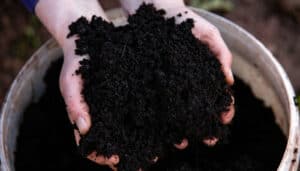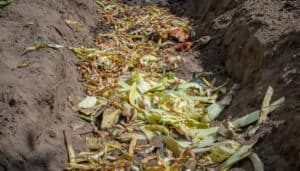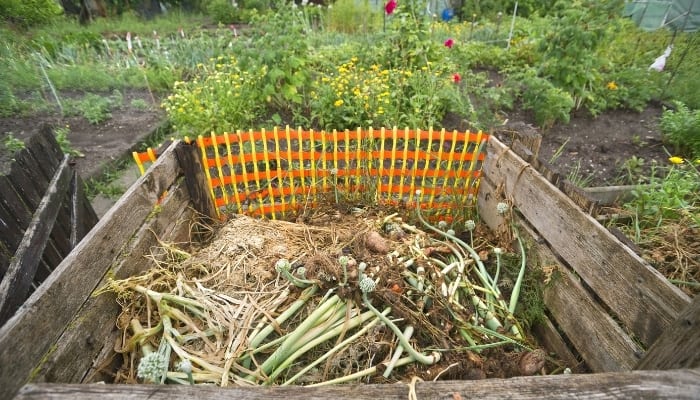A question that frequently comes up is, ‘What is the significance of composting?’ The response is quite straightforward. The purpose of composting is to enhance the quality of the soil mainly used for planting and aid in its sufficient moisture retention.
Quite frankly, the benefits are endless. We could also talk about how it eliminates the need for chemical fertilizers, but instead, we’re going to focus on how it facilitates the breakdown of organic matter, ultimately creating humus.
What Is the Cold Composting Method?
It’s a slow, simple, and more natural composting technique that doesn’t rely on temperature to completely break down the materials in a compost pile. Most gardeners prefer the cold composting method because it isn’t as demanding as the hot composting technique, and produces compost that’s significantly richer in nutrients. Unfortunately, it doesn’t kill harmful pathogens, or weed seeds.
Benefits and Drawbacks of the Cold Composting Process
Now that we all have a rough idea of what cold composting is, let’s jump into the nitty-gritty details.
Cold Composting Basics
The Cold Composting Method
It’s essentially a process that enables microorganisms to break down yard waste and kitchen scraps with an intention of producing an enriching soil additive.
It also happens to be a common practice nowadays, as it demands so little when it comes to maintenance and monitoring.
How Long Does Cold Composting Take?
Ideally, it should be 4-6 months. But you have to factor in the size of the ingre

dient particles, temperature, and more importantly, the type of materials used.
All these things normally do influence the process one way or another.
Say you want a fast decomposition, you’ll have to increase the nitrogen-rich materials, and work with smaller ingredients.
Key Benefits of Cold Composting
Pliability
The one thing that we’ve learned to appreciate about this method is its ability to adapt to different needs.
For example, assuming you don’t have enough materials for the compost, you’re allowed to toss into the pile whatever you have, and add more scraps whenever you get them.
Low Demand for Material
Speaking of materials, did you know you had to have ingredients that could fill at least three cubic feet of space, if you were thinking of taking the hot composting route? Apparently, without that much material, you’re doomed to fail.
Simplicity
The one thing that everybody hates about hot composting is the fact that it’s difficult to maintain a steady temperature. The conditions have to be right for that to happen, leaving little to no room for error.
But with cold composting, you just leave everything there and check the progress once in a blue moon.
Not Affected By Change in Weather
Do you know how hard it actually is to heat up compost during winter? No? Well, you’re lucky you don’t have to find out now that we’re working on a cold compost.
Thanks to this method, the decomposition process won’t be affected even if the temperatures drop to zero. Remember to put a tarp on top of it though. Otherwise, the whole thing will freeze.
Minimal turning
To maintain the heat of a hot compost, you have to turn the pile every so often. That process is important, as it allows air and water to get to those hard-to-reach places.
But for the guys working on cold composting, all that’s not necessary. The pile will take good care of itself.
Useful Microorganisms
By the way, heat is not so great for those microorganisms meant to aid the decomposition process. And that’s why we’re thankful for cold composting.
We know our plants will eventually benefit from the bacteria and fungi acquired from the compost in more than one way.
Drawbacks to Cold Composting
Attracts Insects and Animals
For obvious reasons, pests love hanging around cold composts. Come to think of it, the flies will definitely show up on day one.
You can’t keep them all away, but you can protect it from the larger pests like raccoons with the help of a fence.
Tedious Process
Boring, slow, tiresome, dull, and monotonous are all words that we can use to describe the process. Kind of like watching paint dry, but paint that dries over an extended period of time.
We’re talking about what could possibly be a year.
Slow Process
You have to look for an area that’s strategically located. One that’s closer to your garden, but far away from the main house.
We don’t know why, but gardeners always seem to forget that the pile is supposed to sit in one place for months. And on top of that, it’s usually ugly.
Anaerobic Decomposition Risk
This is actually not something new. And it’s the primary reason why gardeners are always advised to check the pile every once in a while.
You have to ensure that it’s well aerated, or you’ll be welcomed by the smell of a bacterial mess.
Uneven Decomposition
Decomposition happens from the bottom up. But since you won’t be turning the pile every week, some parts will decay faster than others. That’s what causes uneven decomposition.
But then again, it’s a good thing because you could use the compost at the bottom while waiting for the one at the top to break down.
Disease-carrying Pathogens
Besides acting as a catalyst that speeds up the decaying process, hot compost heat is also important for another reason. It normally helps in fighting life-threatening pathogens and breaks down chemical residues.
Just so you know, cold composting is not a method to be used in environments where such pathogens exist.
Alternative Methods of Cold Composting
Lasagna Gardening
Calling it “lasagna gardening” doesn’t mean that we’ll be growing lasagna in the garden. It’s simply a method utilized by gardeners looking to build their gardens in a more organic way.
Sometimes referred to as sheet composting, this technique is all about layering organic materials, and giving them time to cool down. You could give them 4 months or 6 months or a year.
This no-till, no-dig method is beneficial to the environment as it turns waste into organic fertilizer that assists different plants to thrive.
Trench Composting
Trench composting is exactly what you think it is. The gardener will first dig a trench—could be a hole, doesn’t matter— that’s about 12 inches deep.

He or she will then fill that trench with the materials to about six inches, and then cover the remaining space with soil. The goal of this method is to deliver nutrients to the roots of the plants.
Direct Composting
Direct composting is a lot like the trench technique, but different in the sense that you first have to understand what type of waste is to be used as compost material.
Gardeners who’ve been successful with this method have always talked about how it’s important to only use fruit peeling and vegetable scraps as ingredients.
Its goal is to produce enough worms to improve the garden soil.
What’s the Difference Between Hot Composting and Cold Composting?
First of all, you have to understand that both methods are effective for anyone looking to get an incredible soil amendment for a garden.
They’ve both been tried, tested, and proven to be very effective. And now that that’s out of the way, this is all you need to know about their dissimilarities.
Hot Composting
In hot composting, there has to be heat—enough heat to get the pile going. And this is what’s often referred to as optimization. To accomplish this, the pile will demand more nitrogen materials.
If we had to work with a ratio, we’d say an ideal setup should be having 2 parts of carbon for every single part of nitrogen.
Water is also essential in this equation, as it’s needed by the bacteria working to facilitate decomposition. Don’t worry about the oxygen supply, as it will be taken care of by the different materials used to build up the pile.
Because they are of different sizes, they’ll create air pockets that will encourage the movement of air in between spaces.
If the hot composting guidelines are followed to the T, the temperature will rise within a day, and it’ll be hot enough to kill any pathogen or seed weed that might compromise the process.
That temperature has to be maintained for a couple of days. If you see it drop, add more water, and keep turning the pile. It’s definitely time-consuming, but at least you’ll get the desired results faster.
Cold Composting
Cold composting was designed for gardeners who weren’t willing to invest a significant amount of their time in different gardening practices.
This process demands minimal effort, but could take several months to produce compost good enough for gardening.
Cold composting is a lot simpler since it only involves two steps. The first step is to pile your waste, and the second step is to wait. That means you really don’t have to worry about the temperature.
By the way, don’t even think about adding weed seeds into that pile. The reason why it’s called ‘cold’ composting is that not enough heat gets generated during the process.
If you add weed seeds, the temperatures won’t be high enough to deal with them, thus compromising the entire process.
How To Start a Cold Compost Pile
We said ad nauseam that cold composting doesn’t demand a lot from a gardener. Just find a place or site where you can let your pile layer and then decompose.
The steps are:
- Pile the carbon materials at the bottom
- Add a layer of soil on top of them
- Add nitrogen-rich materials
- Add water
And the ingredients/materials aren’t any different from that which you’d typically use while working on a hot compost pile. For carbon supply, you could use twigs, corncobs, sawdust, and even leaves.
If you’re looking for materials rich in carbon, work with weeds (not to be confused with weed seeds), kitchen scraps, and grass clippings.
Just make sure you steer clear of human waste or any sort of fecal matter, fat, weed seeds, meat, or dairy. The low temperature won’t be able to kill any harmful pathogens, so they could find their way into your system.
Additionally, the kitchen scraps have to be buried in the middle, far away from the animals and insects that might disturb the pile.
How Do You Speed Up Cold Composting?
So there are a couple of ways of doing this. If you feel like your compost is taking too long to decompose, you can turn the pile. That will allow more air to get to the bacteria that are facilitating the decaying process.
The other way is to add more nitrogen-rich materials into the pile. They’ll help speed up the reaction, consequently raising the temperature.
Friendly Reminder: Add a little more water every now and then, but don’t make the pile soggy.
How Often To Turn a Cold Compost Pile
Turning a cold compost pile is not necessary. And that’s one of the main benefits of cold composting. But if you feel the need to speed up the process, you could turn it a couple of times, at least once a month.
Don’t turn it too often though. You could end up disrupting the process of actinomycetes and fungi formation, and that’s no good for the composting work.
How Long Does It Take a Compost Pile to Heat Up?
Assuming you’ve built the pile the way it’s supposed to be built, it will take 24 to 36 hours to get to an optimal temperature that falls in the range of 141°F to 155°F.
Anything below that range is not acceptable, as it won’t kill disease pathogens or weed seeds. And if it goes above that, you’ll be killing the very bacteria that are essential to decomposition.
What Happens If Compost Gets Too Cold?
Exactly what you’d expect. The composting process will definitely slow down and eventually stop. Ultimately, this will result in a smelly mess that no one would wish to be associated with.
What we’re basically trying to tell you is, even cold composting needs to be monitored. You have to turn it once a while, and maybe even add some nitrogen-rich materials in the face of freezing temperatures.
How Can You Add Microbes to Compost?
To add microbes to compost, you’ll need a compost starter, an accelerator, or an activator. And you could get one of those in any organic gardening store near you.
These products contain dormant microorganisms that could help you jumpstart the decomposing process, subsequently giving you the ultimate compost.
During application, you first have to dig the pile in several different places. Once you’ve done that, you can go ahead and sprinkle the dry mix before adding water to make the whole thing damp. Not soggy, but damp.
Does Cold Composting Kill Weed Seeds?
No, it doesn’t. Rarely do the temperatures in cold composting rise to levels that are high enough to take care of weed seeds, or harmful pathogens.
If you’ve already added weed seeds into the mixture, you have to find a way to remove them. If you leave them there, the whole place will be covered by weeds the next time you show up to see how the pile’s progressing.
Does Cold Composting Kill Bacteria?
Cold composting does not kill bacteria of any kind. Not even the disease-carrying pathogens. And that’s why you’re always advised to avoid fecal matter from any meat-eating animal.
These pathogens are deadly, as they affect humans in different ways. Some of them might cause mild illnesses, but most are life-threatening.
Is Cold Composting Safe?
Cold compost is in all honesty very safe, and not a bad alternative to hot compost. All you’ve got to do is ensure you’re wary of what you throw into the pile.
If you keep on throwing everything that you find without even taking a second to check if those ingredients contain fecal matter or weed seeds, you’ll find yourself working with something that’s hazardous to humans.
Is Cold Composting Worth It?
Yes, and No.
Yes because it doesn’t require the gardener to invest a lot of time or money into it.
And no, because if you compare it to hot composting, you’ll realize the latter generates a significantly larger volume and is a lot richer in the substances meant to boost plant growth.
Cold Composting Tips
We’ll reiterate this; cold composting is a lot easier than hot composting. Anyone can cold compost, including a beginner who’s never even held a shovel before.
If we had tips to share, they’d be:
- Always consider the location. Preferably, work in a shady area.
- Prepare the space beforehand
- Nitrogen-based materials have to go at the bottom
- The carbon-rich ingredients should go at the top, and after the soil
- Don’t disturb the pile
Conclusion
That’s that, folks! We’ve come to the end of today’s composting piece. But in case you have any questions about the topic, don’t hesitate to reach out.
And this invitation has also been extended to those who feel we’ve left out critical information about the process.

